This is another of my slightly shorter blog posts about arts marketing – again, time dictates I can’t write the mega 5k word epics that I used to churn out semi-regularly. After my last pricing post was hawked around the internet by TRG I thought I’d write something even more niche to really quell any upsurge in interest my blog might be receiving. It’s also been fascinating how many people read that blog and then didn’t say hi. Just saying. Also, and I can tell you’re dying to ask, the show I’m working on is going badly, which is why I’m procrastinating and writing this instead of doing amends to my show so that it’s actually good. So arts professional’s gain is art’s loss. So be it. As always (and no-one ever does) leave me a comment below, join the mailing list or just tweet/linkedin/facebook me to say hi if this is useful.
Cheers, Sam x
I’ve been thinking recently about the myriad of pricing problems we come across on a fairly regular basis.
Not the really individual stuff.
- Mrs Jones being furious because she always sits in A5 and someone else had the audacity to book it before she could.
Or
- Someone managing to go to the wrong theatre, in the wrong town, evading the ushers, sitting in the wrong seat and watching the wrong show that “they didn’t book for” and then being furious they didn’t enjoy it.
Instead the broad brushstrokes stuff.
Things like when audiences don’t book in certain locations, or there’s price resistance, or where the show sells like a dog’s dinner and you need to salvage something for the tall, beardy performer who inexplicably chose to do storytelling rather than musical comedy (which sold better).
So… I created a few scenarios to problem solve in this, very public forum, to explore the options that are available, and some approaches I’ve found useful in the past.
Also… This isn’t a “this is how you do it” post. If you’ve any thoughts or alternative solutions then let me know in the comments – I did these to test myself a little – any thoughts always welcome!
The Theatre
My new and improved fictional theatre has been slightly amended since my last post – it’s now, thanks to a generous grant from the Fictional Arts Council (FAC), a 60 seat studio venue (+10 seats) – you can obviously extrapolate to whatever scale you want – I could have done a bigger venue but frankly that’s more graphic design than I wanted to do today.
My venue has a couple of house seats (F1 & F10), a standard 4 price band approach with specific concessions, and an option that I can do dynamic pricing (if I want) for some flexibility. I’m also not a commercial monster – I want a balance between accessibility and commercial income, because I’m a funded fictional theatre.
Oh and my fictional theatre is in a fictional region. I wanted you to know that not because it makes any difference but because I once was told in a job interview that I lacked “London Experience” so I wanted to make this utterly useless for anyone in London.
Sorry.
I should also say that I bad-mouthed that particular venue in a tour show for 18 gloriously regional performances, so, frankly I think we’re even.
Principles
A few things to start.
It feels fairly obvious but I don’t want to piss the audience off who’ve bought tickets – I want them to feel good about booking early. I’ve also not locked off any seats to help with fill patterns and guide audiences and sales to where I want them. Nor is the pricing plan ideal for my venue (it makes it easier to create scenarios) – I could have designed a shit-hot plan based on a lot of very good, but also very fictional data from my fictional venue’s previous seasons, but instead chose to make it easy.
There’s also a very important thing – these moves all depend at what point the show is in its sales cycle, whether it’s doing well or badly, and also, to an extent, what you need the show to do for you financially.
Finally – I’ve not talked about options for using offers in creative ways (if you’d like me to write a blog post about simple ways to use offers without screwing yourself then tweet me with the words “send me an offer oh wise one”).
Extra finally – I’ve also assumed that your marketing & programming is competent. If it’s not then that might be a hinderance to, y’know, selling tickets.
Scenario #1 – Noone’s Paying More?
So I’ve seen this a few times, where the cheap seats go and then, well nothing, no-one seems willing to buy any of the more expensive seats. It’s price resistance at what you perceive to be low prices.
There’s a few things it could be – the price jump to the next price band could be too much, or it could be that the event has previously been sold at a lower price (regular events – e.g. comedy clubs), or simply that the show looks terrible and no-one except the keen audiences are, well, keen – what is important is that we’re not selling tickets and people aren’t making that jump.
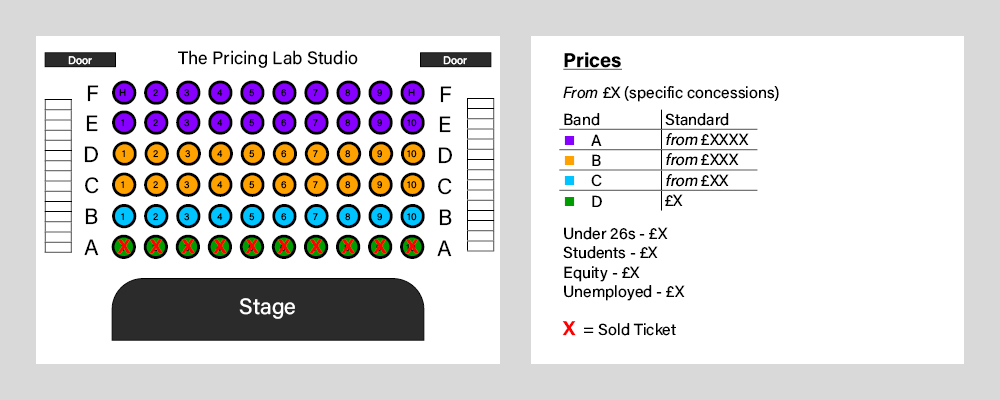
Potential solution(s)?
We could add some band D seats to make sure that we’re selling some tickets, or given that we’ve sold no band C, B or A seats we could reduce the prices of those bands. But they feel like they reduce the perceived value of the product we’re selling rather than increase it. If it is that people think it’s going to be bad then making it cheaper is probably going to reinforce that rather than reduce risk.
There could be some marketing work to try and emphasise the show’s quality, value, importance and profile. Emphasise how seeing it is a necessity not an option. We could also probably do some very strategic offers.
But what about pricing?
I want people to see the show’s value in the pricing, but also, for them to feel like what they’re buying is great value-for-money.
We could re-band some seats (C3-8 and D3-8) as band A and then increase the Band A price – that would help the band C tickets look, comparatively much greater value-for-money.
It’s the classic, making a bargain out of a molehill.
So before it may have been…
- Seat B5 (band C) for £12 and seat C5 (band B) for £18 – A £6 jump in price for two seats that are very similar.
But with the change…
- Seat B5 (band C) for £12 and seat C5 (band A) for £24 – A £12 jump in price for two seats that are very similar.
We’re increasing the perceived value of the seats we want to sell – hopefully motivating purchase by the relative scarcity of that now, increasingly bargainous looking seat.
Scenario #2 – The Landing Strip
This is one where the sides don’t really sell. I think it’s a, probably accurate, perception thing, around sightlines and where the best seat is. If it’s early enough in the sales cycle I generally wouldn’t worry too much about this – maybe lock row F, but if it’s later in the day then creating more of a strip isn’t going to make anyone’s experience great.
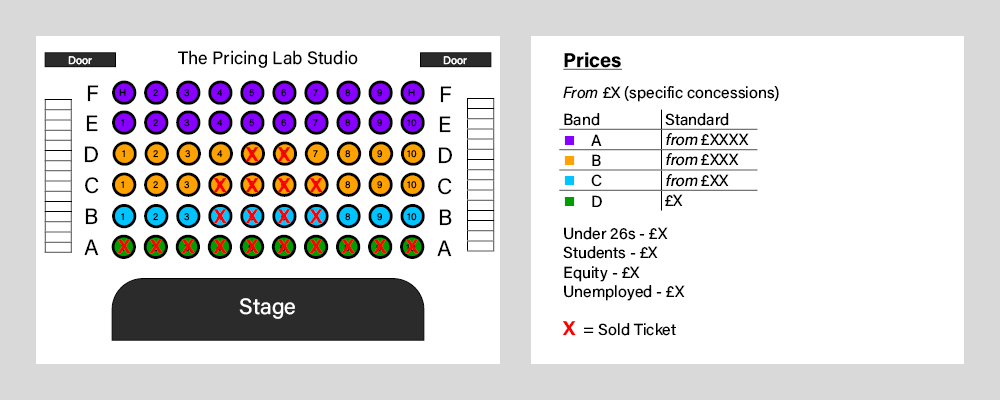
What we could do is…
- Reband B1 & B10 to band D – single lowest cost seats next to the next band up (most people buy in pairs or more) – adding financial motivation to booking the ends.
- Reband C1 & C10 to band C – as above.
We’re acknowledging the lower value but balancing it against cost. We’re also trying to break the taboo that people see when booking. They see the ends not sold – the assumption is then that the ends are bad. If we can sell the ends we can break that taboo/assumption.
If feeling devious we could lock D1 & D2, and also D9 & D10 which may have a similar effect?
Of course, you’re smart, you might say, well doesn’t that devalue the product?
Excellent point.
Possibly.
Scenario #3 – Singles
Sometimes you’re left with some single seats that aren’t easy to sell.
Let’s not get into the politics and relative complexities of people booking to see shows alone. I love seeing shows on my own – and yes box office systems do discriminate against the lone booker. But this blog isn’t about that – more people see shows in pairs (or more).
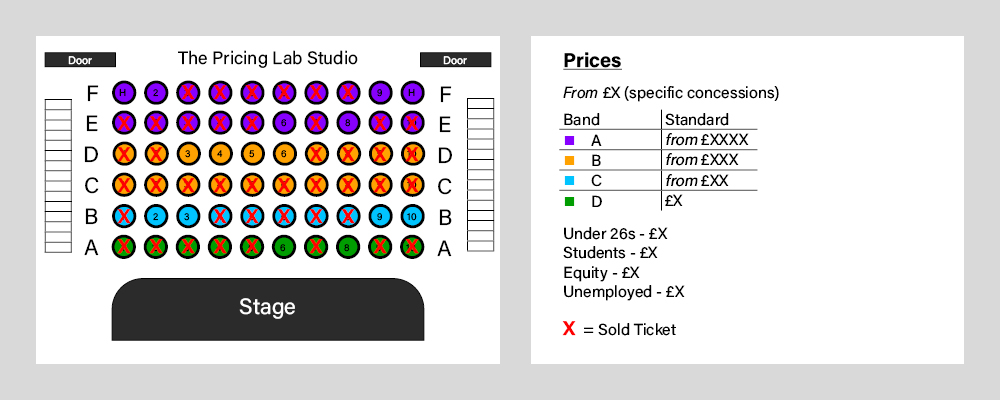
What we could do here is a smart bit of box office action to raise our chances of selling our seats?
- Ring the person who booked A7 if they’d mind moving up a seat to create an easier-to-sell pair – maybe say thank you with a complementary glass of wine?
- Move your house seats F1 and F10 and put them in the single seats, E6 and E8, this creates 2 pairs from 4 singles.
- If the pairs on row F sell then move your house seats to B9 & B10 and ask E7 if they could move please to create and easier-to-sell, higher value pair.
I’ve not moved the house seats into row A because I a) want that row full and b) they’re the lower cost seats and I want those lower-price seats available.
Scenario #4 – Avoiding the front
This happens for comedy nights lots – no-one wants to be picked on. But it causes a problem, an awkward problem. When a room feels empty (even if relatively speaking it isn’t) it can feel flat and deliver (particularly for comedy) a bit of a shit gig. You want everyone, at the front, looking forward with a full front row for the performer to bounce off.
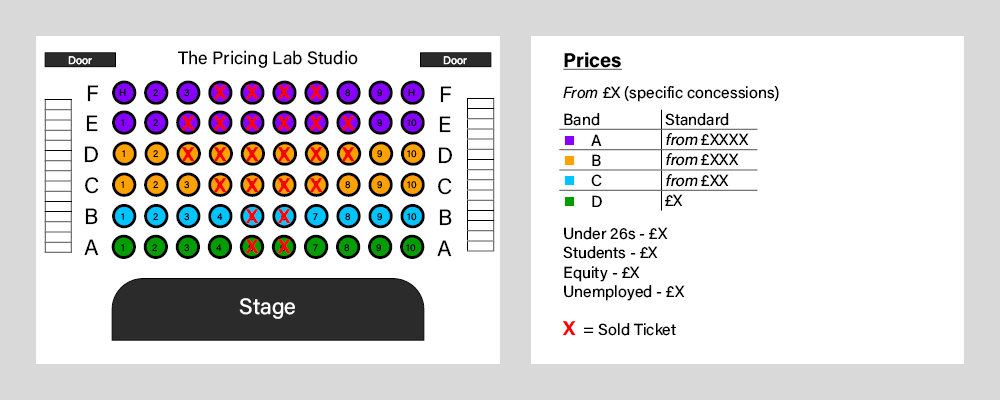
It’ll all depend how long you’ve got until the show is on, but, you could…
- Lock row E & F completely – taking the slight financial hit to help make the experience better
- Lock rows C to F completely – if you’re certain that experience trumps income.
- Increase the price of Band A & B substantially. We want to drive people into those front seats. If it then sells better we may have to reband seats to Band C and then price more dynamically and actively.
A brief bit of backstory – We had this once for a comedy club gig I was running in a function room. 180 people in the audience and the front row, completely empty. COMPLETELY EMPTY. So… 5 mins before the show was due to start we (me and a brill technician called Ben) simply removed and stacked all the seats on row A – very visually without trying to hide what we were doing. The audience absolutely loved it (it was very funny). But crucially we never had that problem again.
Scenario #6 – Storytelling Show Sales
The nightmare scenario.
This happens. It’s happened to me. It’s horrific. BUT, crucially, it doesn’t have to be. There are ways to make this a good experience for all the audience should your creatives/performers be willing to work with you. See what I did there? I made this a team game. We’re all part of the same team to make the experience for the audience great. That’s our win and our shared goal.
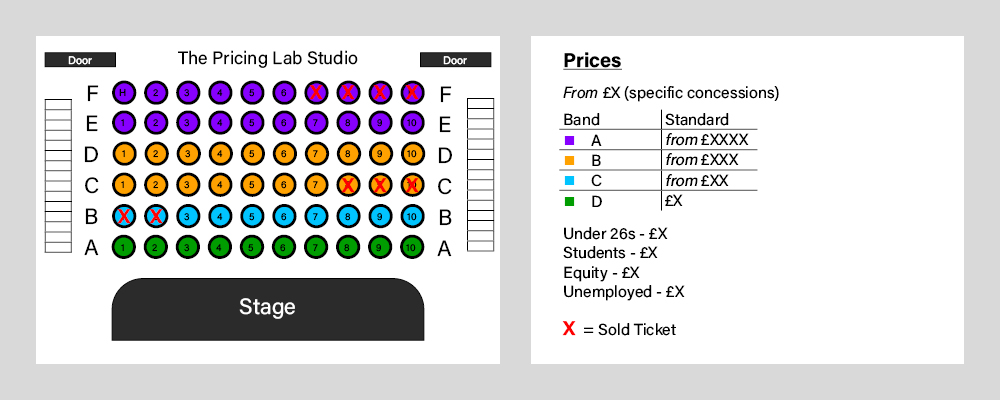
Ask the most lovely, kind and friendly member of the cast to chat to the audience as they come in. Persuade them to move forward. As simple as that. And it really is simple. I’ve done it. It’s fine. It might break the fourth wall, it might lose the intricacies of the opening moment and it might feel hard and moderately degrading, but it will be better experience for everyone.
You should also lock the auditorium down to the front 3 rows as a bare minimum. You could reband C4 – C7 as Band A to keep some price options.
And you should probably also, if you think the show’s going to be good, look at how you can maximise it as an opportunity to reconnect with your audience (in a way that’s conditional and doesn’t seem needy or desperate).
For example:
- A free ticket for your birthday
- Free tickets for long term lapsed attenders (over 5 years)
- Staff (who Christ knows work hard enough so yeah, let ’em in)
- First Timers – Maybe a 2-4-1 as a thank you for them visiting for the first time
- A push for pay-what-you-want for unemployed (or simply a £2 ticket)
I hope this has been, well, at minimum interesting, and maybe even useful. Leave a comment below or hit me up on social media.
Thanks, Sam x